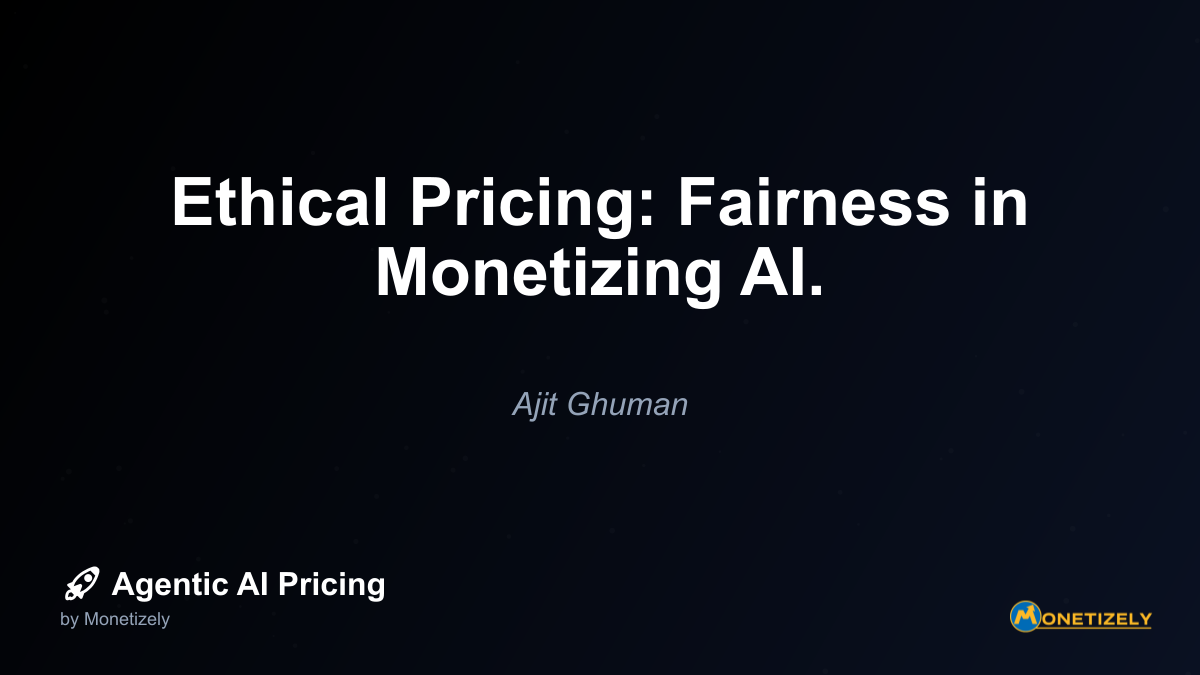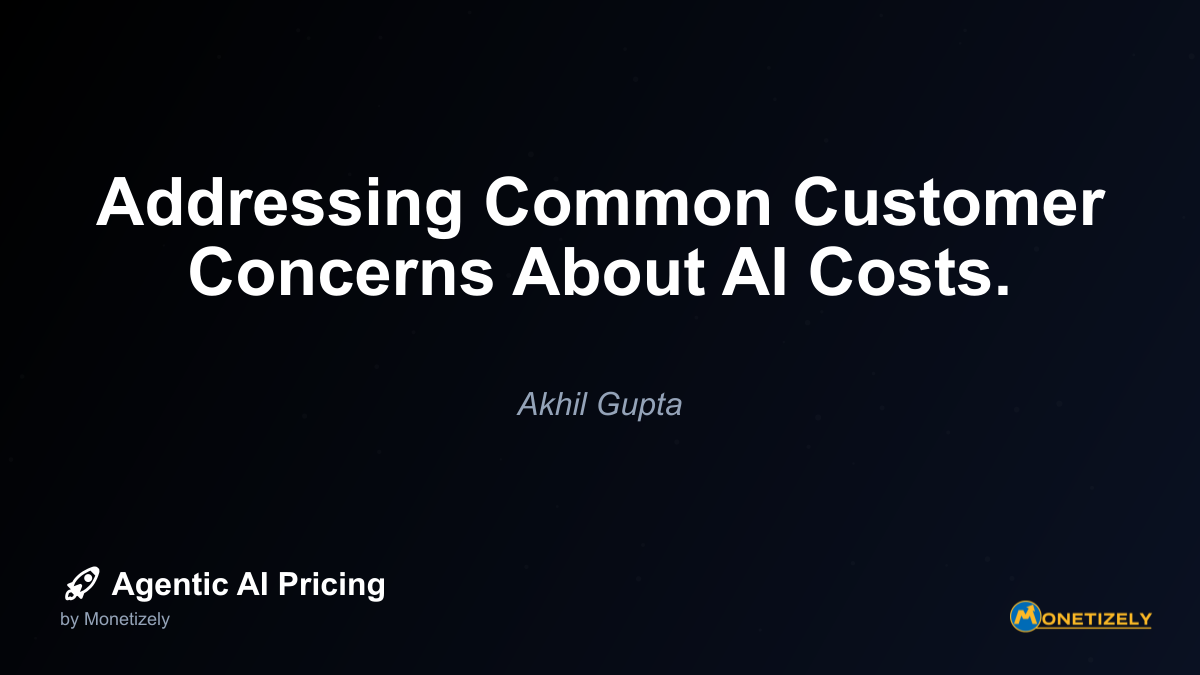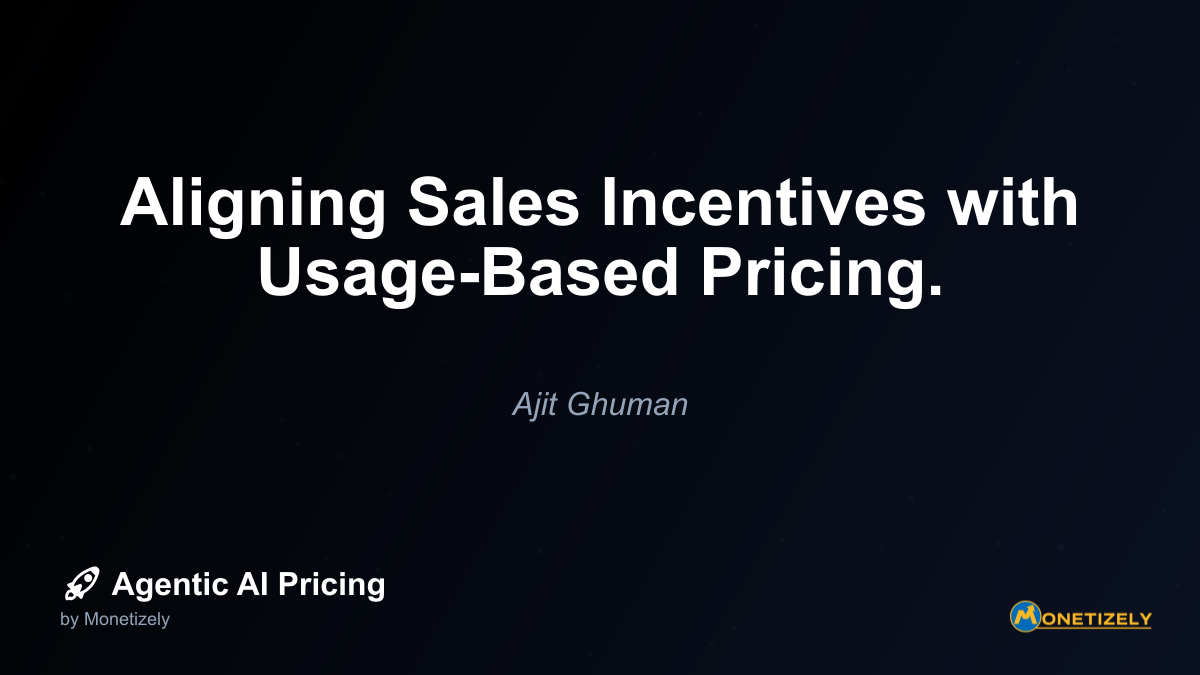· Ajit Ghuman · Best Practices · 10 min read
Ethical Pricing: Fairness in Monetizing AI.
AI and SaaS Pricing Masterclass
Learn the art of strategic pricing directly from industry experts. Our comprehensive course provides frameworks and methodologies for optimizing your pricing strategy in the evolving AI landscape. Earn a professional certification that can be imported directly to your LinkedIn profile.

Ethical considerations are increasingly important in the age of AI monetization, particularly as these powerful technologies become more integrated into essential business functions. While the drive to maximize revenue is natural for any business, there’s growing recognition that ethical pricing strategies lead to more sustainable success and better customer relationships in the long term.
Why Ethical Pricing Matters in AI
The rapid advancement of agentic AI technologies has created unprecedented opportunities for businesses to deliver value. However, this same technological leap has raised important questions about how to price these services fairly. Ethical pricing isn’t merely a philosophical consideration—it directly impacts customer acquisition, retention, and your brand’s reputation in the marketplace.
Research from the Harvard Business Review suggests that 58% of customers consider a company’s ethical stance before making purchasing decisions. For AI products specifically, this number jumps to 67%, indicating heightened sensitivity around technologies that may impact privacy, decision-making, and access to opportunities.
Ethical pricing for AI solutions involves balancing several key considerations:
- Value delivered versus cost charged
- Accessibility across different customer segments
- Transparency in pricing structures
- Fairness in contract terms and conditions
- Responsible handling of customer lock-in
Companies that navigate these considerations thoughtfully not only build stronger customer relationships but also position themselves for sustainable growth in an increasingly competitive landscape.
The Hidden Costs of Unethical Pricing
Before exploring best practices, it’s worth understanding the potential consequences of pricing strategies that prioritize short-term gains over ethical considerations.
Damaged Brand Reputation
In today’s hyper-connected world, pricing practices perceived as exploitative quickly become public knowledge. Customers share experiences across social media platforms, review sites, and industry forums. A single viral post about predatory pricing can cause significant reputational damage that may take years to repair.
For example, when a leading AI document processing company implemented a sudden 400% price increase for existing customers in 2022, the backlash was immediate. The company lost 22% of its enterprise customers within three months and saw its valuation drop by $1.2 billion.
Regulatory Scrutiny
As AI technologies become more prevalent, regulatory bodies worldwide are paying closer attention to pricing practices. The European Union’s Digital Markets Act and similar legislation in other jurisdictions increasingly target unfair pricing practices, particularly for technologies considered essential infrastructure.
Businesses that proactively adopt ethical pricing frameworks may avoid costly compliance issues and potential fines that can significantly impact profitability.
Customer Churn
While exploitative pricing may boost short-term revenue, it typically leads to higher customer churn rates. Research by Bain & Company shows that increasing customer retention by just 5% can increase profits by 25% to 95%. Conversely, pricing practices that erode trust can accelerate customer departures.
This is particularly relevant for AI solutions, where implementation costs and switching costs are often substantial. Once customers feel exploited, they become motivated to overcome these barriers and find alternative solutions.
Core Principles of Ethical AI Pricing
Developing an ethical pricing framework for AI technologies requires careful consideration of several key principles:
1. Value-Based Pricing Aligned with Outcomes
Ethical pricing starts with a clear understanding of the value your AI solution delivers. Rather than pricing based solely on development costs or competitor benchmarks, ethical pricing focuses on the measurable outcomes customers achieve.
This approach naturally leads to pricing models that align incentives between vendor and customer. For instance, a legal AI tool might charge based on successful document processing rather than a flat subscription, ensuring customers only pay for demonstrable value.
2. Transparency and Simplicity
Complex pricing structures with hidden fees, unexpected charges, or confusing tiers create friction and erode trust. Ethical pricing emphasizes transparency through:
- Clear communication of all costs upfront
- Straightforward explanations of how pricing scales with usage
- Honest comparisons between different pricing tiers
- Elimination of hidden fees or surprise charges
Companies like Anthropic have received positive attention for their transparent pricing approach to their Claude AI assistant, clearly communicating both token costs and how these translate to typical usage scenarios.
3. Fair Access Across Market Segments
Ethical pricing recognizes that AI technologies can deliver value across different customer segments with varying ability to pay. Strategies to ensure fair access include:
- Tiered pricing based on organization size or resources
- Educational or non-profit discounts
- Free tiers with meaningful functionality
- Pay-what-you-can models for certain markets
By ensuring broader access, companies not only fulfill ethical obligations but often discover new market opportunities and use cases that might otherwise remain unexplored.
4. Reasonable Contract Terms
Contract terms that heavily favor the vendor create imbalanced relationships that ultimately undermine trust. Ethical approaches include:
- Reasonable notice periods for price changes
- Flexible contract durations without excessive penalties
- Fair data ownership and portability provisions
- Clear exit paths that don’t trap customers
Avoiding Customer Lock-In Exploitation
One of the most concerning ethical issues in AI pricing is the exploitation of customer lock-in. As organizations integrate AI systems into their operations, the switching costs increase dramatically, potentially creating situations where vendors can exploit this dependency.
Recognizing Lock-In Dynamics
Customer lock-in occurs when the costs (financial, operational, or technical) of switching to an alternative solution become prohibitively high. In AI systems, lock-in can stem from:
- Proprietary data formats and lack of interoperability
- Customizations that can’t be easily transferred
- Integration with multiple systems creating complex dependencies
- Employee training and familiarity with specific interfaces
- Accumulated data that provides increasing value over time
Ethical Approaches to Managing Lock-In
Forward-thinking companies recognize that while some degree of lock-in is inevitable in complex systems, exploiting this position ultimately backfires. Ethical approaches include:
1. Price Stability Commitments
Providing clear guidelines around how prices may change over time gives customers confidence in their investment. Some companies offer price caps or guaranteed maximum increase percentages that provide predictability for long-term planning.
2. Data Portability Guarantees
Ensuring customers can easily extract their data in standard formats reduces one of the most significant switching barriers. This approach demonstrates confidence in your solution’s value beyond mere captivity.
3. Open APIs and Integration Standards
Supporting open standards and providing comprehensive APIs allows customers to maintain flexibility and control over their technology stack, even while deeply integrating your AI solution.
4. Transparent Renewal Processes
Avoiding automatic renewals with significant price increases or providing ample notice before renewal deadlines shows respect for customer autonomy and decision-making.
Pricing Essential AI Services Ethically
As AI becomes increasingly integrated into critical business functions, questions arise about how to price services that may become essential infrastructure.
Identifying “Essential” AI Services
Not all AI applications carry the same ethical weight when it comes to pricing. Services that might be considered essential include:
- AI tools that enable compliance with regulatory requirements
- Systems that provide accessibility for users with disabilities
- Solutions that have become industry standards for certain functions
- Technologies that significantly impact economic opportunity
Graduated Pricing for Essential Services
Ethical pricing for essential services often incorporates graduated approaches that ensure basic access while allowing for premium features at higher price points:
- Core functionality at accessible price points
- Advanced features at market rates
- Premium capabilities for those willing to pay for maximum value
This approach ensures that essential capabilities remain accessible while still allowing companies to capture appropriate value from premium offerings.
Building Trust Through Fair Pricing Communication
How pricing is communicated significantly impacts customer perception of fairness. Ethical communication practices include:
Clear Value Articulation
Helping customers understand the specific value they receive at different price points creates context for pricing decisions. This might include ROI calculators, case studies, or detailed feature comparisons that justify premium pricing.
Honest Competitive Positioning
While it’s natural to highlight competitive advantages, ethical pricing communication avoids misleading comparisons or cherry-picked metrics that don’t reflect real-world usage scenarios.
Transparent Pricing Changes
When price increases become necessary, ethical companies:
- Provide substantial advance notice (typically 3-6 months for enterprise solutions)
- Clearly explain the rationale behind increases
- Offer grandfathering options or phased transitions for existing customers
- Deliver additional value alongside price changes when possible
Case Studies in Ethical AI Pricing
OpenAI’s Tiered Approach
OpenAI’s approach to GPT pricing demonstrates several ethical principles in action. The company offers:
- Free access with reasonable usage limits
- Affordable subscription for individual professionals
- Enterprise pricing with additional features and support
- Usage-based pricing that scales with value received
This model ensures accessibility across segments while capturing appropriate value from enterprise customers who derive the greatest benefit.
Anthropic’s Transparent Token Economics
Anthropic has earned praise for its straightforward approach to pricing Claude, its AI assistant. The company:
- Clearly explains token economics and how they translate to real usage
- Provides detailed pricing examples for different use cases
- Offers predictable pricing without hidden fees
- Communicates technical improvements that reduce costs for customers
Responsible Price Increases: Salesforce Einstein
When Salesforce needed to adjust pricing for its Einstein AI capabilities, the company demonstrated ethical practices by:
- Providing six months’ notice before implementation
- Offering grandfathered pricing for existing customers
- Adding significant new capabilities alongside the price change
- Creating migration paths for customers with different needs
Practical Implementation of Ethical Pricing Frameworks
Moving from principles to practice requires systematic approaches to pricing decisions. Organizations committed to ethical pricing typically implement structured frameworks:
1. Value Assessment Protocols
Develop systematic methods to assess and quantify the value your AI solution delivers to different customer segments. This might include:
- Customer interviews and usage analysis
- ROI measurement frameworks
- Competitive value benchmarking
- Total cost of ownership calculations
2. Ethical Review Boards
Some organizations establish dedicated review processes for pricing decisions that consider ethical implications alongside business objectives. These boards might include:
- Customer advocates
- Ethics specialists
- Product managers
- Executive leadership
- Independent advisors
3. Fairness Audits
Regular reviews of pricing outcomes help identify unintended consequences or emerging issues:
- Analyze usage and value patterns across customer segments
- Identify potential accessibility barriers
- Review customer feedback specifically related to pricing
- Compare outcomes against stated ethical objectives
Balancing Business Sustainability and Ethical Pricing
While ethical considerations are paramount, pricing must ultimately support business sustainability. Companies that excel at ethical pricing find ways to align these objectives rather than viewing them as trade-offs.
Premium Pricing for Premium Value
Ethical pricing doesn’t mean charging less than the value delivered. When AI solutions provide exceptional value, premium pricing can be both profitable and fair. The key is ensuring that:
- Premium prices correspond to premium value
- The value proposition is clearly articulated
- Customers have appropriate options at different price points
Operational Efficiency as Ethical Practice
Improving internal efficiency allows companies to maintain reasonable prices while preserving margins. Investments in areas like:
- Deployment automation
- Infrastructure optimization
- Self-service capabilities
- Improved documentation
These investments can reduce delivery costs, allowing for more accessible pricing without sacrificing profitability.
Long-Term Relationship Focus
Companies that view pricing through a relationship lens rather than a transactional one often discover that ethical pricing leads to greater lifetime value through:
- Higher retention rates
- Increased expansion revenue
- More referrals and positive word-of-mouth
- Reduced customer acquisition costs
The Future of Ethical AI Pricing
As AI technologies continue to evolve, several emerging trends will likely shape ethical pricing practices:
Usage-Based Models with Guarantees
More sophisticated usage-based pricing that includes outcome guarantees is gaining traction. These models align vendor incentives with customer success while providing predictability through caps or minimum performance thresholds.
Community-Informed Pricing
Some organizations are experimenting with more participatory approaches to pricing, including:
- Customer councils that provide input on pricing strategies
- Transparent discussions about cost structures and margins
- Community voting on feature prioritization that influences pricing tiers
Ethical Differentiation
As markets mature, ethical pricing practices are becoming competitive differentiators. Companies that build reputations for fairness can command premium positions even in crowded markets.
Conclusion: The Competitive Advantage of Ethical Pricing
Ethical pricing for AI technologies isn’t merely a moral imperative—it’s increasingly a competitive necessity. As customers become more sophisticated in their evaluation of AI solutions and more sensitive to issues of fairness and accessibility, companies that embrace ethical pricing principles gain significant advantages:
- Stronger customer relationships built on trust and mutual benefit
- Reduced regulatory risk as oversight of AI technologies increases
- More stable revenue from improved retention and expansion
- Positive brand differentiation in crowded markets
- Broader market access through accessible entry points
Organizations that view ethical pricing as central to their strategy rather than a constraint on profit maximization ultimately build more resilient businesses capable of sustainable growth.
The most successful companies recognize that in AI pricing, as in other aspects of business, ethics and economics are increasingly aligned. By prioritizing fairness, transparency, and value alignment, businesses can achieve both moral and market leadership in the rapidly evolving AI landscape.
Co-Founder & CEO
Ajit is the author of Price To Scale, a top book on SaaS Pricing and is the Founder of Monetizely. Ajit has led and worked in pricing and product marketing at firms like Twilio, Narvar and Medallia. His work has been featured in Forbes and VentureBeat. Ajit regularly consults with software companies from Seed stage to post-IPO on pricing strategy. Ajit is also a highly-rated co-instructor for 'The Art of SaaS Pricing and Monetization' on Maven.
Pricing Strategy Audit
Let our experts analyze your current pricing strategy and identify opportunities for improvement. Our data-driven assessment will help you unlock untapped revenue potential and optimize your AI pricing approach.




